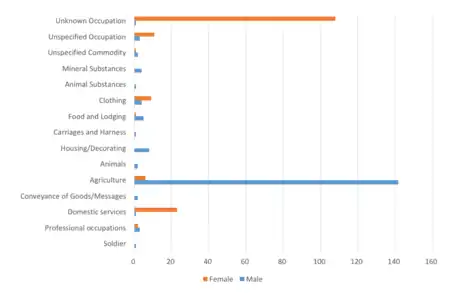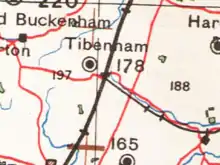Tibenham, Norfolk
Tibenham is a village and civil parish located in the Depwade district of South Norfolk, England. The parish is 2 miles (3.2 km) north west of Tivetshall railway station.[1] It has a pub called The Greyhound.
| Tibenham | |
|---|---|
 All Saints, Tibenham | |
 Tibenham Location within Norfolk | |
| Area | 13.34 km2 (5.15 sq mi) |
| Population | 494 |
| • Density | 37/km2 (96/sq mi) |
| OS grid reference | TM137898 |
| • London | 86 miles (138 km) SW |
| Civil parish |
|
| District | |
| Shire county | |
| Region | |
| Country | England |
| Sovereign state | United Kingdom |
| Post town | NORWICH |
| Postcode district | NR16 |
| Dialling code | 01379 |
| Police | Norfolk |
| Fire | Norfolk |
| Ambulance | East of England |
| UK Parliament | |
History
In 1870–72, John Marius Wilson's Imperial Gazetteer of England and Wales described Tibenham as:[2]
"a parish, with a village, in Depwade district, Norfolk; 2 miles NW of Tivetshall r. station, and 7½ S by E of Wymondham...The church is good; and there are a Primitive Methodist chapel"
Within Tibenham is a RAF Airfield used between 1916 - 1920 and 1942 - 1959.
RAF Tibenham
RAF Tibenham is an airfield and Royal Air Force station located 13.5 miles (21.7 km) southwest of Norwich and 5.8 miles (9.3 km) north of Diss, Norfolk, England. The site was controlled by the Royal Flying Corps, United States Army Air Forces and the Royal Air Force.
An extract from Norfolk Gliding Club Air Show and Open Day Programme, Sunday 14 September 1975 by James Stewart titled "Wings over Tibenham":
"When you looked across the airfield, there would have been perhaps twenty or thirty of the big bombers in the olivedrab camouflage dispersed all around the maze of hardstandings leading off the perimeter track....from this base [I] flew 20 combat missions in B. 24.H. Liberators and was Commander of the 703rd Bombardment squadron of the 445th Group."
The Dad's Army episode Round and Round went the Great Big Wheel was filmed at RAF Tibenham.
Population demographics
The village has a population according to the 2011 census of 494: 239 males and 255 females.[3]

The population of Tibenham as reported by the Census of Population from 1801 to 2011 appears to show a trend in population throughout the course of time. The total population of Tibenham appears to take a sharp rise between the duration of 1801 and 1851, peaking in 1841, which totalled to 727 people.[4] A steep fall that appears to level off slightly around 1901 onwards can be identified. The population of Tibenham appears to be stagnant between the period of 1951 and 2001, in which both Census' total population at 454.[4]
Occupational structure
According to archived census data, in 1881 the population of the village measured at 707.[5] With the southward shift in industry within the country, as well as a shift in career opportunities, it can be seen that Tibenham has since seen a decline in population with the 2011 census totalling to 494.

The occupations that were available to the village in 1881 can be described as rural with most, if not all, occupations centring around the life and needs of the village community. A large majority of men were involved in agriculture. The total number of 142 includes occupations such as farmers, graziers as well as accounting for their sons, grandsons, brothers and nephews involved in the occupation. Other agricultural occupations included farm bailiff's, agricultural labourers, farm servants, cottagers and agricultural machine proprietors and attendants.
According to the 1881 census females were involved in a select number of occupations, for example being largely involved in domestic services compared to men. Domestic services include domestic indoor servants and washing and bathing services. However a large majority of women were registered as part of an "unknown occupation".
All Saints' Church
The eighty-seven and a half foot tower of All Saint's Church is Tibenham's most recognisable and prominent landmark. Within the church are 12 steps that lead to the ringing chamber with a further 35 steps that reach a heavily bound and reinforced door.[6] It is suggested that this was once the treasury. The architecture of the chancel and nave were influenced by the English Gothic era (1250 - 1350), the south aisle and tower to the Perpendicular period (1350 - 1550). The east end of the south aisle at one time constituted the St. Nicholas chapel, and was constructed in the sixteenth century.[6] The church received £31,500 of Heritage Lottery funding in 2003 to renovate and re-cast its bells.[7]

References
- "Parish population 2011". Retrieved 6 September 2015.
- Wilson, John Marius (1870–72). Imperial Gazetteer of England and Wales. A. Fullerton & Co.
- "Tibenham (Parish) Key Figures for 2011 Census: Key Statistics". Neighbourhood Statistics. Office for National Statistics. Retrieved 25 April 2016.
- "GB Historical GIS / University of Portsmouth, Tibenham CP/AP through time | Population Statistics | Total Population, A Vision of Britain through Time". Retrieved 25 April 2016.
- "GB Historical GIS / University of Portsmouth, Tibenham CP/AP through time | Population Statistics | Males & Females (10 years earlier), A Vision of Britain through Time". Retrieved 25 April 2016.
- "All Saints' Church". Retrieved 25 April 2016.
- "Tibenham Church Bells". Heritage Fund.
External links
![]() Media related to Tibenham at Wikimedia Commons
Media related to Tibenham at Wikimedia Commons